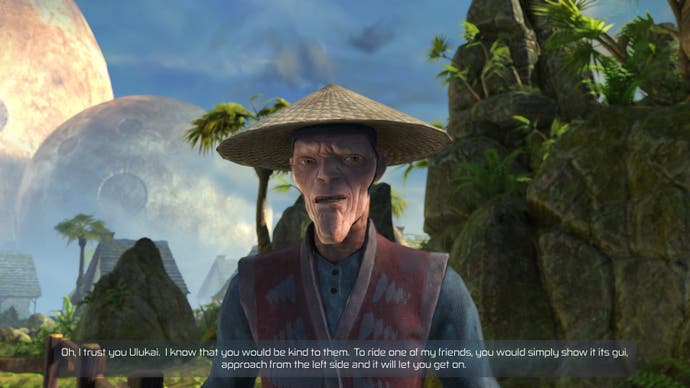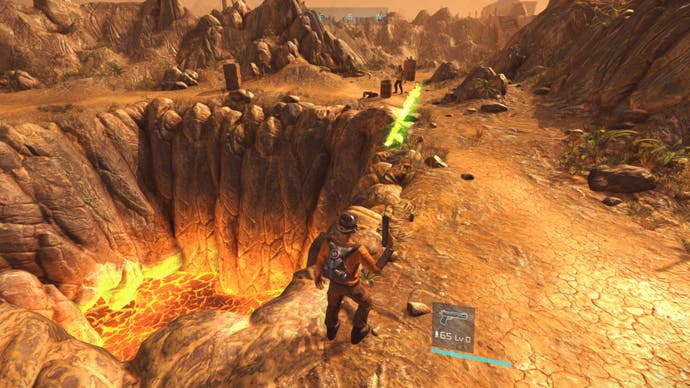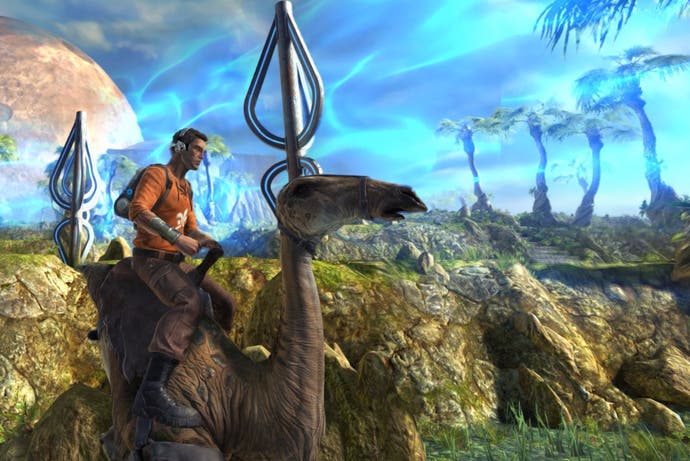Outcast - Second Contact review
It's back, ulukai people.
Initially turned off by its stock 1990s action game protagonist and fuzzy voxels, I came to appreciate Outcast rather late in life. At the time of its original release I craved titles that would put my fancy new GeForce 256 to good use, for which I was spoilt for choice: a new Dungeon Keeper was atop the PC hit parade, which, together with Hidden & Dangerous, System Shock 2 and Unreal Tournament, effortlessly outshined Outcast's dull palette.
It wasn't until a full 15 years later that I gave Outcast the attention it had long deserved. This was at the time of the v1.1 release, an understated - and still worthwhile - remaster that, in facilitating an outpouring of affectionate reader reviews across GOG and Steam, stirred in me old curiosities and a dormant sense of guilt at having dismissed the original game so easily.
And so, after years of wilful ignorance (and fresh from having completed Far Cry 4), I pushed myself to fall for Outcast's charms. It took a fair while. For many hours Cutter Slade remained every bit the second-rate Korben Dallas I'd suspected that he was, but eventually his out-dated wisecracks broke through and the pudgy faces of the indigenous Talan, in delivering their redundant vowels in Parisien kebab shop accents, forever endeared me to their plight. Before long I was hunting high and low for fabled Essence Stones and the missing brothers of peasant farmers, plundering abundant resources for ammo and, slowly but surely, turning the culpable and often cowardly administrators of the harsh Adelphan regime into unwitting allies in my insurgent efforts to save two worlds.
And Second Contact, in spite of what little it offers in terms of fundamental change, has had me happily doing it all over again.

For the benefit of those who weren't doing a whole lot of interacting back in the autumn of 1999, or, like me, had convinced themselves there were better games with which to fill their time, I should probably explain what the big deal with Outcast was, aside from an obvious aversion on the part of it's development team to fully embrace 3D hardware acceleration.
Outcast was, in short, an incredibly ambitious and moderately successful third-person action adventure, one that offered the freedom to explore an alien land from atop a twon-ha (space ostrich), while interacting with characters that seemed to go about their business regardless of whether you helped them or not. Despite genre hybrids being a thing at the time, there wasn't much else like it, certainly not in 3D Fuzz-O-Vision.
Chiefly inspired by Stargate, seemingly guided by the spirit of Edgar Rice Burroughs and with flourishes that invited fleeting comparisons with Ocarina of Time, Outcast also happened to predate GTA3 by a couple of years, which has led some to champion the game as establishing the principles of open world gaming. Personally I think it sat more comfortably alongside other prototypical efforts like Beyond Good & Evil, Captain Blood, Robinson's Requiem and Little Big Adventure - where their developers had established distinct and compelling worlds long before layering them with whatever passed for interactivity at the time. That all the above were also a bit weird, delightfully meandering, and, ostensibly, French, has only added to their cult charm.
And yes, before you rush to the comments, I know Outcast was conceived in Belgium.

In spite of the misleading subtitle, Second Contact is not Outcast's aborted sequel. In fairness, Appeal aren't asserting that it is. What it is claiming Second Contact to be is a "complete remake", which is also a little deceptive. In truth what we have is a renovation, with most of the work applied to the game's graphical exterior. In many ways that's a good thing, because while Outcast has mechanics that may to some newcomers feel hopelessly outdated, it would have been a massive loss had they been entirely replaced with something modern and ubiquitous.
I'm thinking specifically of the combat system, which in the original game was somewhat kludgy and not at all like any kind of shooter before or since, which was fine because Outcast was never much of a run-and-gun game in the first place, even though many people (myself included) had preemptively lumped it in with the equally alien and enticing Giants: Citizen Kabuto.
You only have to sink a couple of hours into any version of the game to realise that Outcast's combat has more in common with a twin-stick arcade game, a treacly third-person Robotron with enemies you can easily kite and weapons fire you can sidestep - thankfully without the infinite and instant enemy respawns. That may not seem very inspired, but it's actually quite refreshing to have targets to lead, which together with the game's explosive gadgets and deployable teleport pads, make for encounters than feel more like puzzles than realistic firefights. Movement is a little pacier in Second Contact and Cutter Slade's old ineffectual shimmies have been replaced by modern ducks and rolls, but none of it takes anything away from the spirit of Outcast's endearingly lumpy battles.

While very little has changed in the guts of the game, it's a very different picture on the surface of Adelpha, where we can reliably estimate the vast majority of the developer's renovation budget has been spent. Not much landscaping has been done however, with towns, villages and all the various cut throughs almost identical, down to every winding walkway and character-snagging nook. For veterans the familiarity of each region is more than welcome, almost like revisiting a beloved teenage haunt that has barely changed (at least in the mind's eye), but newcomers will surely baulk at the sometimes unnecessary blocks placed in the world, such as the antiquated need to find some steps in order to exit water.
Perhaps Adelpha is a little less otherworldly now that it's displayed in Unity-O-Vision, but that could just be over familiarity getting the better of me. In any case the new colour palette is quite striking, with the just the right level of contrast and vibrancy to still seem distinct while hopefully offsetting the engine's ubiquity. The more verdant regions of Adelpha are considerably more thick with fauna than I recall, and while the world as a whole lacks the environmental detailing and dynamic effects we expect of a new release, the new vistas still manage to impress.
As for Adelpha's population The Talan are considerably less neanderthal than they originally were, and while their repertoire of animations is limited, they remain as likeable a bunch of NPCs as you'll find outside of Oddworld. And despite the fact that Cutter Slade has received a considerable overhaul in terms of his range of movement, I'm glad to report that he's retained a little of his marionette gait, which is rather fitting as he now looks a lot like Thunderbird 1's Scott Tracy after being assaulted with a pool cue. It's not a popular opinion among returning fans, but I prefer new-look Slade, who also happens to suit his old voice rather well

Which neatly brings me to my main issue with the game, the voices. Not that they're bad, since the audio is directly copied over from the original game. The problem is that legacy Outcast came with a lot of spoken word that had to be squeezed with all the rest of the code onto two CDs, and that, on the basis of what's here, would seem not to exist in any uncompressed state anywhere else. Unfortunately the voice track's already low fidelity is made noticeably worse by contrasting spectacularly with the newly minted HD visuals. To 21st Century ears it's like it was pulled off some old 4-track tape that was rotting in a shed for 20 years. You soon learn to put up with it - there's no choice but to - but some high range environmental effects would surely have helped mask the issues. In fairness, the voice track was something the devs wanted to re-record, not just to improve quality, but to update some of the script's rather dated cultural references. Had the original Kickstarter bid crossed the line, things might have been different.
There are other, lesser issues, mostly around the lack of graphical and control options: There's no way to mousewheel your way out of zoomed in skull when you're surrounded by scenery, for instance, which rather irritatingly is usually when under attack. Similarly, given the vast amount of gobbledygook in the game, subtitling is an initially welcome option that rather goes overboard with its inline translations, so much so that you'll quickly turn the feature off. Finally the inventory screen is hopelessly basic, especially with regard to quest and lore information. There doesn't need to be more of it, it just needs to be better presented.
For the most part Second Contact is a glorious remaster, essential for fans and a worthy introduction for newcomers who want to sample an open-world adventure that requires a bit of thought and patience. It's a notable effort for leaving much of the underlying game and it's 90s soul intact, while switching out the original graphics for visuals that, whole not bleeding edge, are a generational triple jump beyond even 2014's overdue update. One or two legacy features could have been dumped without taking the game too far out of its place in time, and some meaningful supplementary content would have been welcome, but it's only really the untouched soundscape that stands out as a missed opportunity to make Outcast feel truly refreshed and relevant.
Y'know, I almost wish I'd held on a few more years to play what is now the definitive edition of Outcast, but I realise now there's only so long you can hold out and 15 years was probably long enough. Which reminds me, I should probably get around to Final Fantasy 7 one of these days. I hear it's quite good.

